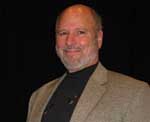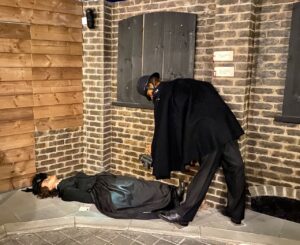By Jerry Klinger

I had heard bits and pieces growing up about the infamously fabled killer, Jack the Ripper.
Ghoulish murders and murder mysteries were never of particular interest to me especially when they involved horrific mutilations of the victims. The subject matter was just plain unpleasant to contemplate.
Yet, always in the back of my mind, like many Jews who know how tenuous Jewish existence can be even in the most tolerant of environments, antisemitism can flare out of nowhere and strike. The first thought to cross my mind when something terrible happens is, I hope the perpetrator was not a Jew.
Jack the Ripper murdered at least five women, the “canonical victims,” slashing their throats, disemboweling, and stealing organs with swift, precise, surgical coldness. The unsolved murders occurred in Whitechapel/Spitalfields area of East London, 1888-1891. The “canonical five” were the victims most researchers agree were murdered by Jack the Ripper. During the period, an additional nine victims, possibly more, were thought linked to the Ripper.
The East End of London, an area near the docks, was an area of extreme poverty, misery intermixed with British human detritus and densely packed with desperate Jewish refugees from Russia and Eastern Europe.

Contemporary British police investigations identified seven suspects. Two were Jews, John Pizer and Aaron Kosminski. In time, “Ripperologists,” popular culture’s name for Jack the Ripper sleuths and hucksters, identified 28 possible suspects. From the basest people to Prince Albert Victor, Duke of Clarence and Avondale, second in line to the British throne, were fingered as Jack the Ripper. Even Louis Carrol, the author of Alice’s Adventures in Wonderland, got a shout out as Jack the Ripper.
Who was Jack the Ripper, who were his victims, the why and where, the reasons for what he did has stayed intriguing for over 130 years. Books, movies, articles, websites, Madame Tussauds, a museum in Whitechapel, continue to churn out materials on the Ripper.
I thought Jack the Ripper was a minor alcove of interest to the esoterically curious, until just recently. Jack the Ripper being Jewish was not something I had much considered. Others have, and seriously so.
A Jewish Jack the Ripper has brought out the worst antisemitic social media internet hate. Google refuses to take the bile down as a “Violation of Community Standards.”
The sleeping anxiety, let him not be Jewish, came back.
The U.S. is not exempt for the irrational bite of antisemitism. The massive surge of antisemitic incidents in 2021 is a fact. It is accompanied by mostly liberal media outlets trying to delegitimize, to villainize Israel, the “Jewish state.”
The most heinous of invented lies, the blood libel, that Jews used the blood of Christian children in their religious rituals, occurred in Messina, N.Y., 1928, two days before Yom Kippur, the Jewish day of atonement. Four-year-old Barbara Griffiths went missing. A rumor began. The Jews had taken her. The chief of police, who had grown up with Jews and was close to Jews all his life, accepted the possibility of the blood libel as legitimate. He began a serious investigation into the Jews.
The investigation ended only when the little Barbara was found alive and well. She had wandered off and fallen asleep in the woods.
In the past few months, story after story has come out, including The Jewish Press, such as The Jerusalem Post, and Haaretz. Modern DNA analysis has finally determined who Jack the Ripper was they said. A piece of physical evidence, a blood-stained victim’s apron was analyzed. It was found on a Jewish street, not far from the Great synagogue of Whitechapel and a Jewish Socialist Workers Club. Above the evidence, on the wall, was scrawled an oblique condemnation:
“The Juwes are the men that will not be blamed for nothing.”
The controversial DNA analysis pointed the finger to Aaron Kominsky.
The murder of the women in Whitechapel brought out the seething nativist British tensions against the immigrant Jews. Jews were attacked in the streets. Jews fought back.
The brutality of the murders, the mutilation of the sliced open bodies, the harvesting of uteruses, kidneys, raised cries of Jewish blood rituals.
Ironically, the blood ritual accusation was first invented by the English. William of Norwich was a little boy in 1144. He vanished a few days before Passover. The boy’s brutally murdered body was found. The Jews were accused. The local sheriff, John de Chesney, refused to prosecute the Jews because there was no evidence. He took the Jews into his castle to protect them from the mobs. King Stephen initially refused to prosecute the Jews too.
The damage was done. The infection of the blood libel entered the mainstream of the English world. The blood libel led to massacres of Jews in York and London. King Edward the First banished all Jews from England, July 18, 1290.
It would be almost 400 years before Jews could return to England.
The blood libel lie spread throughout Europe. It refused to die. Popes decried the libel as a horrific falsehood. They too, could not stem the hate.
William was eventually canonized. His burial site in the Norwich Cathedral remained a pilgrimage shrine until just after the Holocaust.
Being aware of the extreme rise of antisemitism in the U.K., I wanted to understand how the Jack the Ripper Museum in Whitechapel presented Aaron Komisky. I was traveling for various projects to the U.K. It was a minor detour for my airport driver.
The museum is housed in a small, narrow, non-descript Victorian building. I almost did not realize I was there when the driver pulled up to let me out.
A black woman, speaking in crisp Jamaican accented English, took my admission fare. She directed me up a narrow flight of stairs.
I asked her about how they interpreted the Jewish character of recently accused Jack the Ripper, Aaron Kominsky.
“Oh, we don’t identify anyone’s ethnicity or religion,” she said, pointing me to the narrow, dark wood staircase. “Be sure and go to all five floors.”
Touring the building and the modest exhibits, I learned more from my attendee educator at the entrance as I was leaving. I stopped to ask her another question.
“Did the Jews live amongst the Christians?” I asked.
She answered, “The Jews tended to live close by each other but were mixed in with the Christian community. The murders were mainly in the Jewish areas. The feelings against the Jews were very bad and dangerous. The Police Commissioner protected the Jews.”
Her last comment struck me. It was not what I had expected, “the Police Commissioner protected the Jews.” Being seriously froggy headed from jet lag and needing to get to an appointment, I left cataloging her words for later.
The tensions against the Jews of Whitechapel for the murders of Mary Ann Nichols, Annie Chapman, and Elizabeth Stride were explosive when the bloody apron was found under the scrawl pointing to the Jews on Ghoulston Street. Catherine Eddowes was victim number 4.
Police Commissioner Sir Charles Warren arrived at the scene. He made a crucial decision. He had the writing pointing to the Jews erased. He wrote to the Home Office:
“…it was just getting light, the public would be in the streets in a few minutes, in a neighborhood very much crowded by Jewish vendors and Christian Purchasers from all parts of London…The writing was on the jamb of the open archway or doorway visible to anybody in the street and could not be covered up without danger of the covering been torn off at once. A discussion took place whether the writing could be left covered up or otherwise…for an hour until it could be photographed; but after taking into consideration the excited state of the population in London…the strong feeling which had been excited against the Jews, and the fact that in a short time there would be a large concourse of the people in the streets, and having before me a report that if it was left there the house was likely to be wrecked (in which from my own observation I entirely concurred) I considered it desirable to obliterate the writing at once…I do not hesitate to say that if the writing had been left there would have been an onslaught upon the Jews, property would have been wrecked, and lives would probably have been lost…”
The short 30-minute detour to the Jack the Ripper Museum and the dark side taught me something good.
Could the murderer have been a Jew? Perhaps. What was importantly learned was that to prevent evil from growing to envelop the innocent, good people must be willing to step forward and make hard, controversial decisions such as Sir Charles Warren had.
*
Jerry Klinger is the President of the Jewish American Society for Historic Preservation (www.JASHP.org)
http://www.algemeiner.com/2020/01/23/debunking-the-myth-of-a-jewish-jack-the-ripper/
Jerry
I come from, and live in Whitechapel. Its pretty offensive language to use the term “human detritus” to refer to people living in the East End at that time.
Yes, it was a rough existence, but many were, like the Jews, refugees from terrible conditions at home. The Irish, my roots, had come to the East End in huge numbers too because they had had to flee the impact of the Irish Famine and British Govt failure to address that and provide effective reluef in the 1840s.
You refer to the Jack the Ripper Museum on Cable Street. Local people reject this ghoulish celebration of the appalling murder of several local women and the strange visitors it brings to the area.
The “museum”, I prefer horror show, was established on false pretences, with a planning application being submitted on the basis of creating a women’s museum. It really has no place in our local community.
I’d recommend checking out the views of the respected local historian the Gentle Author for more on this concern.